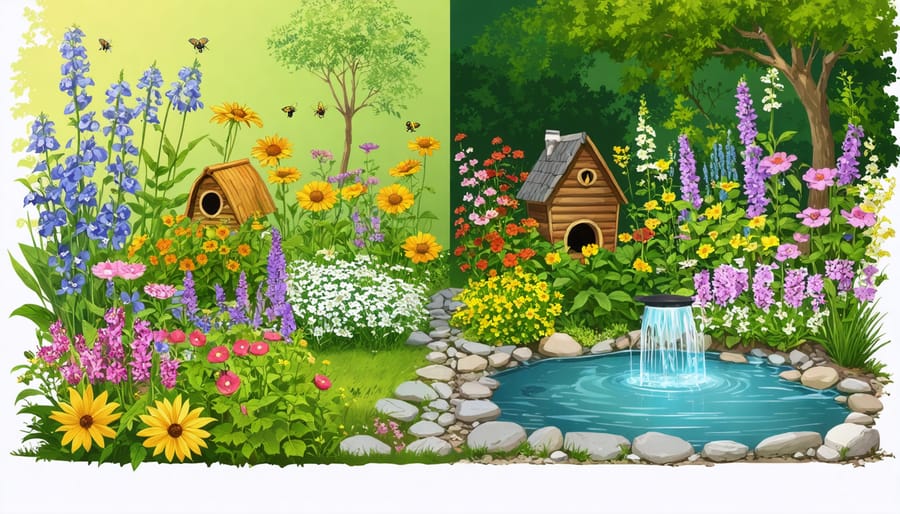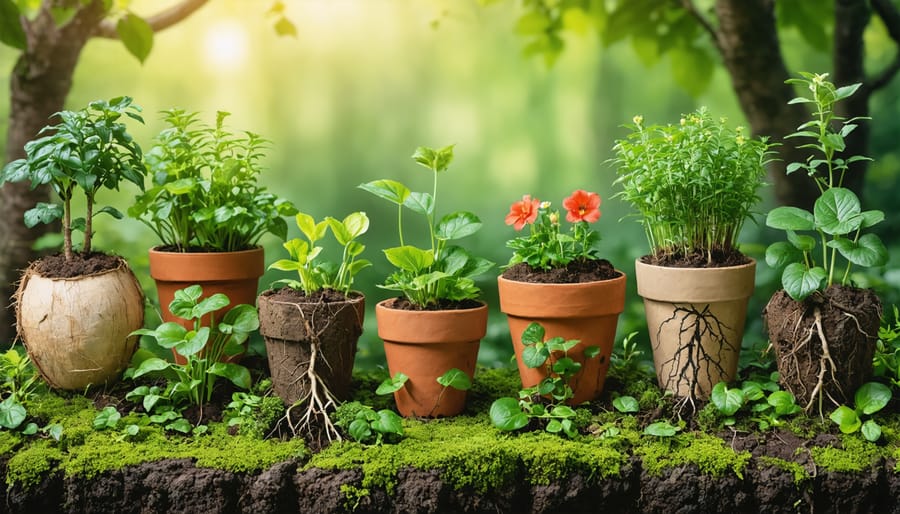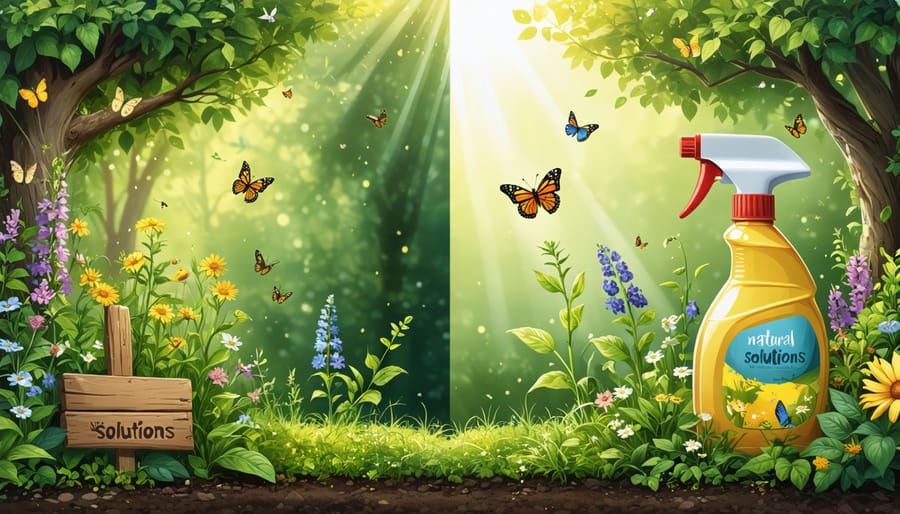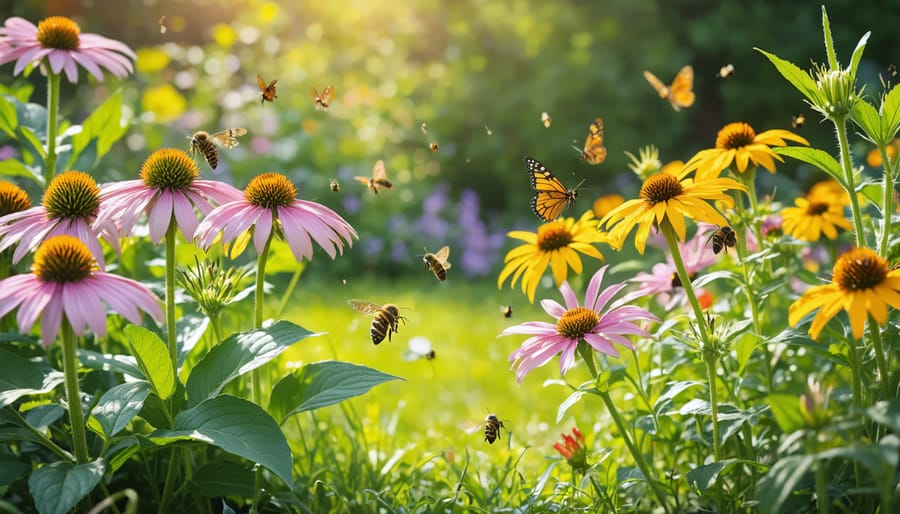Transform your garden into a vibrant pollinator paradise by incorporating native flowering plants in clusters of three to five specimens, creating essential food sources and natural habitats. Plant diverse species that bloom across different seasons – from early spring bulbs to late autumn asters – ensuring continuous nectar availability for bees, butterflies, and beneficial insects. Implement these earth-friendly gardening practices by eliminating chemical pesticides and providing shallow water sources through bird baths or pebble-filled dishes. Design your space with layers of varying heights, combining tall perennials like echinacea and salvias with ground-covering natives, creating multiple feeding zones that attract different pollinator species. Modern innovations like smart irrigation systems and pollinator monitoring apps now make it easier than ever to maintain these wildlife-friendly spaces while conserving resources and tracking your garden’s impact on local ecosystems.
Smart Design Strategies for Maximum Pollinator Appeal
Creating Pollinator Corridors
Creating a pollinator corridor is like designing a highway system for bees, butterflies, and other beneficial insects. By planning a continuous path of blooming plants throughout your garden, you’ll ensure these vital creatures have access to food and shelter all season long. Start by mapping your garden and identifying the natural flight paths pollinators might take. Consider incorporating these paths into your existing climate-smart garden design for maximum impact.
Layer your plantings with varying heights, creating a tiered effect that attracts different types of pollinators. Tall flowers like hollyhocks and foxgloves can serve as beacons, while medium-height plants like coneflowers and salvias provide landing spots. Ground-covering plants like creeping thyme offer additional nectar sources.
Plan your corridor to maintain continuous blooms from early spring through late fall. Start with spring bulbs like crocuses, transition to summer favorites like bee balm and butterfly bush, and finish with autumn bloomers like asters and goldenrod. Group similar plants in clusters of at least three to five specimens – this makes them more visible to passing pollinators.
Remember to include resting spots along your corridor. Small brush piles, native grasses, or bee hotels provide shelter and nesting sites. Keep your corridor at least three feet wide where possible, and avoid creating gaps larger than ten feet between flowering areas to maintain an unbroken chain of resources for your garden visitors.
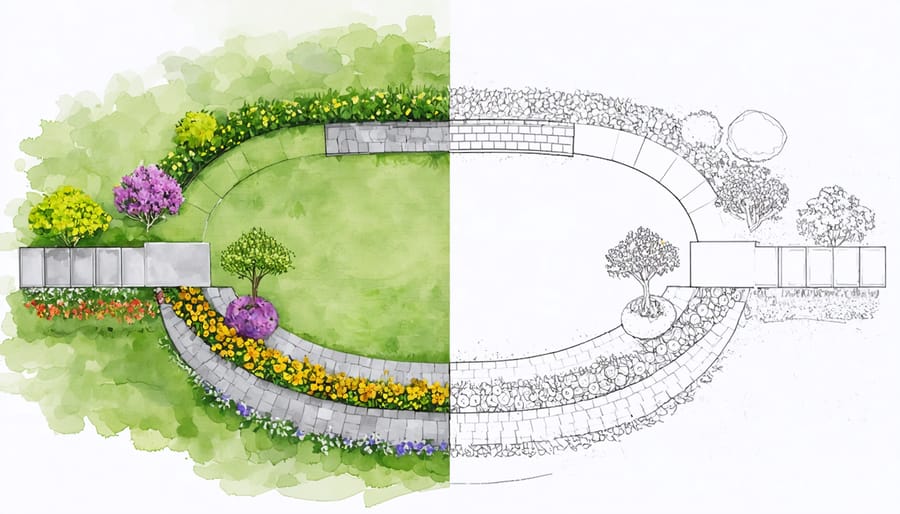
Water Features That Work
Providing clean, fresh water is essential for attracting pollinators to your garden, but it’s important to create safe drinking spots that won’t become hazards. Modern water features can be both beautiful and functional while keeping our buzzing friends safe from drowning.
A popular approach is the pebble fountain, where water gently trickles over stones of varying sizes. The rocks provide safe landing spots for insects to perch while they drink. You can create this easily by adding a layer of river rocks to an existing fountain or birdbath.
For a low-maintenance option, try a shallow dish garden with pebbles and moss. Fill a wide, shallow container with stones, add water just below the stone level, and incorporate some moisture-loving moss around the edges. This creates a natural-looking water source that requires minimal upkeep.
Another innovative solution is the “bee puddle” – a shallow dish filled with sand and pebbles, kept consistently moist but not flooded. Place it in a sunny spot near flowering plants, and you’ll soon see pollinators gathering for a drink.
Remember to maintain your water features regularly by cleaning them weekly and keeping water levels consistent. In winter, heated water sources can provide crucial hydration for winter-active pollinators in moderate climates.
Avoid deep, steep-sided containers, and always ensure there are plenty of landing spots and escape routes for insects that might fall in.
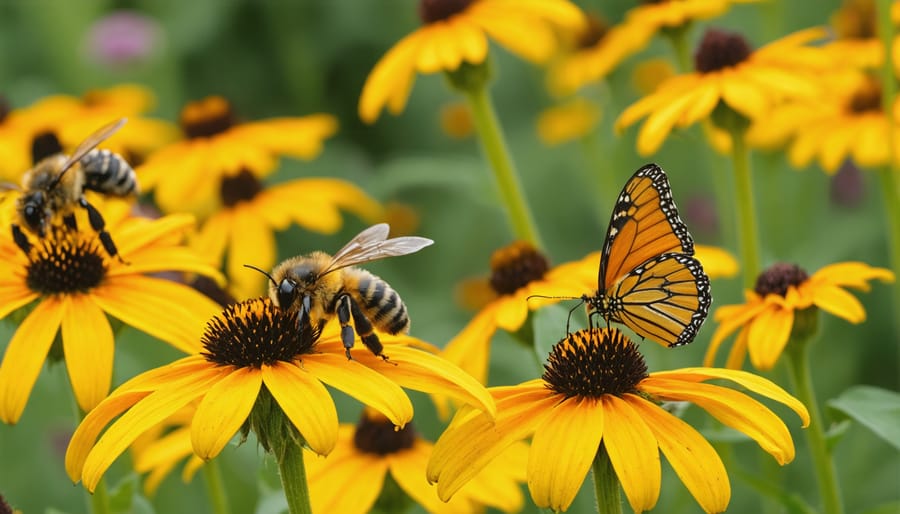
High-Impact Plants That Pollinators Can’t Resist
Season-by-Season Blooming Strategy
Creating a garden that blooms throughout the growing season is like orchestrating a beautiful symphony of colors and fragrances for pollinators. Start your planning by dividing the growing season into three main periods: spring, summer, and fall.
For early spring, plant bulbs like crocuses, snowdrops, and grape hyacinths that emerge when many pollinators are just becoming active. Follow these with spring-flowering perennials such as columbine, bleeding heart, and native woodland phlox. These early bloomers provide crucial nutrition for emerging bees and butterflies.
As spring transitions to summer, incorporate plants like coneflowers, bee balm, and native salvias. Layer your garden with different heights and bloom times – tall delphiniums can provide vertical interest while shorter catmint creates flowing ground coverage. Include herbs like oregano, thyme, and basil, which not only attract pollinators but are useful in the kitchen too.
Late summer to fall is a critical time for pollinators preparing for winter. Plant asters, goldenrod, and sedum to provide late-season nectar sources. Don’t forget about flowering shrubs like butterfly bush and native viburnums that can provide structural interest and food sources throughout multiple seasons.
Keep detailed notes about bloom times in your garden and adjust your plant selection each year. Consider creating a simple spreadsheet or garden journal to track when different species flower. This helps identify any gaps in your blooming sequence and ensures continuous nectar sources for your pollinator friends throughout the growing season.
Remember to include at least three plants for each blooming period, and aim for clusters of the same species rather than single specimens. This makes your garden more visible and attractive to passing pollinators.
Native Plant Innovations
The world of native plants is evolving, with plant breeders developing exciting new varieties that maximize pollinator appeal while offering enhanced garden performance. These innovative cultivars maintain the ecological benefits of their wild ancestors while featuring improvements in bloom time, disease resistance, and garden aesthetics.
One breakthrough has been the development of extended-blooming varieties of popular natives like Echinacea and Rudbeckia. These new selections can flower for up to three months, providing pollinators with a longer-lasting food source. The ‘Magnus Superior’ coneflower, for instance, produces larger nectar-rich flowers and sturdier stems than the original species.
Native plant breeders have also focused on creating compact varieties perfect for smaller gardens. The new ‘Little Joe’ Joe Pye Weed grows to just 4 feet tall, compared to its 7-foot wild cousin, while still attracting countless butterflies and bees. Similarly, dwarf varieties of native asters and goldenrod bring pollinator power to patio containers and urban gardens.
Color breakthroughs have expanded the palette of pollinator-friendly plants. New selections of native Penstemon now come in vibrant purples and pinks, while maintaining the tubular flower structure that hummingbirds love. The ‘Standing Ovation’ Little Bluestem offers enhanced blue-gray foliage and stronger winter presence while providing essential habitat for native bees.
Disease resistance has been another focus area, with new varieties of Monarda and Phlox showing impressive resistance to powdery mildew while retaining their butterfly-magnet qualities. These improved plants require less maintenance and stay attractive throughout the growing season, making it easier than ever to create successful pollinator gardens.
Tech-Savvy Pollinator Support
Smart Irrigation for Pollinator Gardens
Keeping your pollinator garden properly watered is crucial for both plant health and nectar production. Modern smart irrigation systems have revolutionized how we maintain these vital habitats, making it easier than ever to create the perfect environment for butterflies, bees, and other beneficial insects.
The key is to water deeply but less frequently, encouraging roots to grow deeper into the soil. Consider installing a drip irrigation system with a timer, which delivers water directly to the plant base while keeping leaves and flowers dry. This approach not only conserves water but also prevents fungal diseases that can harm your pollinator-friendly plants.
For optimal results, set your irrigation schedule for early morning hours. This timing allows plants to absorb water before the day heats up and reduces evaporation loss. Many modern systems now include moisture sensors that automatically adjust watering based on soil conditions and weather patterns.
Remember to group plants with similar water needs together in your garden design. This practice, known as hydrozoning, ensures that each plant receives just the right amount of water. For example, place drought-tolerant natives like butterfly weed and black-eyed susans in one zone, while thirstier plants like cardinal flowers can share another irrigation zone.
Consider adding a rain barrel to your setup to collect natural rainfall. This sustainable approach provides chemical-free water that many pollinators prefer, while helping reduce your environmental impact and water bills.
Pollinator Monitoring Tools
Modern technology has revolutionized how we monitor and support our garden’s pollinators. Several user-friendly tools are now available to help gardeners track and enhance pollinator activity. The most popular are mobile apps that help identify different species of bees, butterflies, and other pollinators visiting your garden. These apps often include features for logging sightings and contributing to citizen science projects.
Motion-sensor cameras designed specifically for garden monitoring have become more affordable and accessible. These devices can capture detailed footage of pollinator visits throughout the day, helping you understand which plants are most attractive to different species and when peak activity occurs.
Digital weather stations with built-in pollinator activity predictors can help you plan your gardening schedule around optimal pollination times. These smart devices monitor temperature, humidity, and wind conditions – all factors that influence pollinator behavior.
For those interested in supporting native bee populations, electronic bee hotels with monitoring capabilities allow you to observe nesting activity. Some models even include temperature and humidity sensors to ensure optimal conditions for your beneficial insects.
Pollinator tracking platforms and online databases enable gardeners to share their observations and connect with other enthusiasts in their area. These community-driven tools help create a broader understanding of pollinator patterns and population trends while fostering a network of like-minded gardeners committed to supporting these essential creatures.
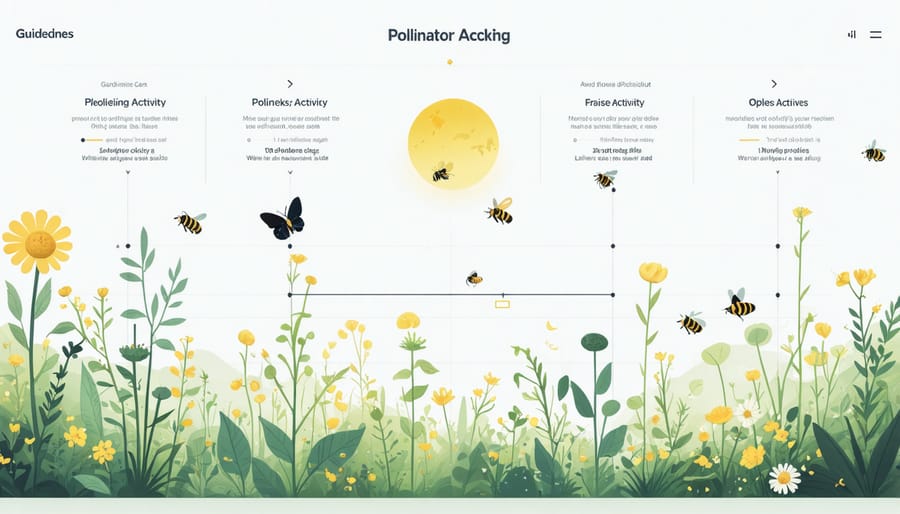
Sustainable Maintenance Made Simple
Maintaining a pollinator-friendly garden doesn’t have to be complicated or time-consuming. The key is working with nature rather than against it. Start by embracing a “less is more” approach – let your garden be a little wild, as pollinators often prefer natural-looking spaces.
One of the most important practices is to maintain healthy garden soil without harmful chemicals. Use organic compost and mulch to nourish your plants naturally. This not only helps your plants thrive but also creates a healthy ecosystem for ground-nesting bees and other beneficial insects.
When it comes to pruning and cleanup, timing is everything. Leave spent flowers on plants during fall and winter – they provide food and shelter for pollinators. Wait until early spring to cut back dead plant material, giving overwintering insects a chance to emerge. If you must tidy up, create a brush pile in a quiet corner of your garden instead of disposing of all the material.
Water wisely by using a soaker hose or drip irrigation system early in the morning. This allows flowers to dry by evening, preventing fungal issues while ensuring pollinators have access to nectar throughout the day. Consider installing a shallow water feature with landing spots for insects to drink safely.
Pest management should focus on prevention and natural solutions. Encourage beneficial insects by planting diverse species and avoiding broad-spectrum pesticides. If you notice pest problems, try hand-picking insects or using targeted organic solutions that won’t harm pollinators.
Remember to mow your lawn less frequently and set your mower blade higher. This allows clover and other flowering “weeds” to bloom, providing additional food sources for pollinators. Consider converting part of your lawn into a wildflower meadow – it’s less maintenance and more pollinator-friendly!
By following these simple practices, you’ll create a thriving habitat that supports pollinators while keeping your garden beautiful and manageable.
Creating a pollinator-friendly garden is more than just a hobby – it’s a meaningful contribution to our environment and local ecosystem. By incorporating the principles and practices we’ve discussed, you’re not only creating a beautiful outdoor space but also providing essential support for bees, butterflies, and other crucial pollinators.
Remember, starting small is perfectly fine. Even a few native plants in containers or a small flower bed can make a difference. Focus on providing a diverse range of flowers that bloom throughout the seasons, avoid pesticides, and ensure a reliable water source. The key is to create a welcoming habitat that supports pollinators throughout their life cycles.
Don’t forget to observe and learn from your garden as it develops. Watch which plants attract the most pollinators and how different species interact with your garden. This knowledge will help you make better choices as you expand your pollinator paradise.
Your efforts will be rewarded with a vibrant, buzzing garden that not only looks beautiful but also plays a vital role in supporting local biodiversity. Plus, you’ll enjoy better yields from your fruits and vegetables, thanks to increased pollination.
So why wait? Start planning your pollinator-friendly garden today. Every flower you plant is a step toward a healthier environment and a more sustainable future. Together, we can create a network of pollinator havens that make a real difference in our communities.

